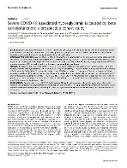| dc.contributor.author | Gojda, Jan | |
| dc.contributor.author | Koudelková, Kateřina | |
| dc.contributor.author | Ouřadová, Anna | |
| dc.contributor.author | Lang, Alexander | |
| dc.contributor.author | Krbcová, Magdaléna | |
| dc.contributor.author | Gvozdeva, Alexandra | |
| dc.contributor.author | Šebo, Viktor | |
| dc.contributor.author | Slagmolen, Lotte | |
| dc.contributor.author | Potočková, Jana | |
| dc.contributor.author | Tůma, Petr | |
| dc.contributor.author | Rossmeislová, Lenka | |
| dc.contributor.author | Anděl, Michal | |
| dc.contributor.author | Karpe, Fredrik | |
| dc.contributor.author | Schlesinger, Sabrina | |
| dc.date.accessioned | 2023-12-29T09:40:41Z | |
| dc.date.available | 2023-12-29T09:40:41Z | |
| dc.date.issued | 2023 | |
| dc.identifier.uri | https://hdl.handle.net/20.500.14178/2153 | |
| dc.description.abstract | BACKGROUND: COVID-19, an infectious disease caused by SARS-CoV-2, was shown to be associated with an increased risk of new-onset diabetes. Mechanisms contributing to the development of hyperglycemia are still unclear. We aimed to study whether hyperglycemia is related to insulin resistance and/or beta cell dysfunction. MATERIALS AND METHODS: Survivors of severe COVID-19 but without a known history of diabetes were examined at baseline (T0) and after 3 (T3) and 6 (T6) months: corticosteroids use, indirect calorimetry, and OGTT. Insulin response and sensitivity (IS) were expressed as insulinogenic (IGI), disposition (DI), and Matsuda insulin sensitivity index (ISI). Resting energy expenditure (REE) and respiratory quotient (RQ) was calculated from the gas exchange and nitrogen losses. RESULTS: 26 patients (out of 37) with complete outcome data were included in the analysis (age ~59.0 years; BMI ~ 30.4, 35% women). Patients were hypermetabolic at T0 (30.3 +- 4.0 kcal/kg lean mass/day, ~120% predicted) but REE declined over 6 months (ΔT6-T0 mean dif. T6-T0 (95% CI): -5.4 (-6.8, -4.1) kcal/kg FFM/day, p < 0.0001). 17 patients at T0 and 13 patients at T6 had hyperglycemia. None of the patients had positive islet autoantibodies. Insulin sensitivity in T0 was similarly low in hyperglycemic (H) and normoglycemic patients (N) (T0 ISI(H) = 3.12 +- 1.23, ISI(N) = 3.47 +- 1.78, p = 0.44), whereas insulin response was lower in the H group (DI(H) = 3.05 +- 1.79 vs DI(N) = 8.40 +- 5.42, p = 0.003). Over 6 months ISI (ΔT6-T0 mean dif. T6-T0 for ISI (95% CI): 1.84 (0.45, 3.24), p = 0.01)) increased in the H group only. CONCLUSIONS: Patients with severe COVID-19 had increased REE and insulin resistance during the acute phase due to the infection and corticosteroid use, but these effects do not persist during the follow-up period. Only patients with insufficient insulin response developed hyperglycemia, indicating that beta cell dysfunction, rather than insulin resistance, was responsible for its occurrence. | en |
| dc.language.iso | en | |
| dc.relation.url | https://doi.org/10.1038/s41387-023-00241-7 | |
| dc.rights | Creative Commons Uveďte původ 4.0 International | cs |
| dc.rights | Creative Commons Attribution 4.0 International | en |
| dc.title | Severe COVID-19 associated hyperglycemia is caused by beta cell dysfunction: a prospective cohort study | en |
| dcterms.accessRights | openAccess | |
| dcterms.license | https://creativecommons.org/licenses/by/4.0/legalcode | |
| dc.date.updated | 2023-12-29T09:40:41Z | |
| dc.subject.keyword | COVID-19 | en |
| dc.subject.keyword | hyperglycemia | en |
| dc.subject.keyword | beta cell dysfunction | en |
| dc.subject.keyword | prospective cohort study | en |
| dc.relation.fundingReference | info:eu-repo/grantAgreement/GA0/GA/GA22-22398S | |
| dc.relation.fundingReference | info:eu-repo/grantAgreement/MSM//LX22NPO5104 | |
| dc.relation.fundingReference | info:eu-repo/grantAgreement/UK/SVV/SVV260531 | |
| dc.relation.fundingReference | info:eu-repo/grantAgreement/UK/COOP/COOP | |
| dc.date.embargoStartDate | 2023-12-29 | |
| dc.type.obd | 73 | |
| dc.type.version | info:eu-repo/semantics/publishedVersion | |
| dc.identifier.doi | 10.1038/s41387-023-00241-7 | |
| dc.identifier.utWos | 001031355100001 | |
| dc.identifier.eidScopus | 2-s2.0-85165034475 | |
| dc.identifier.obd | 633682 | |
| dc.identifier.pubmed | 37460458 | |
| dc.subject.rivPrimary | 30000::30200::30202 | |
| dcterms.isPartOf.name | Nutrition & Diabetes | |
| dcterms.isPartOf.issn | 2044-4052 | |
| dcterms.isPartOf.journalYear | 2023 | |
| dcterms.isPartOf.journalVolume | 13 | |
| dcterms.isPartOf.journalIssue | July | |
| uk.faculty.primaryId | 110 | |
| uk.faculty.primaryName | 3. lékařská fakulta | cs |
| uk.faculty.primaryName | Third Faculty of Medicine | en |
| uk.department.primaryId | 110 | |
| uk.department.primaryName | 3. lékařská fakulta | cs |
| uk.department.primaryName | Third Faculty of Medicine | en |
| uk.department.secondaryId | 100027057758 | |
| uk.department.secondaryId | 633 | |
| uk.department.secondaryId | 581 | |
| uk.department.secondaryName | Ústav hygieny 3. LF UK | cs |
| uk.department.secondaryName | Department of Hygiene 3FM CU | en |
| uk.department.secondaryName | Interní klinika 3. LF UK a FNKV | cs |
| uk.department.secondaryName | Department of Internal Medicine 3FM CU and UHKV | en |
| uk.department.secondaryName | Ústav patofyziologie 3. LF UK | cs |
| uk.department.secondaryName | Department of Pathophysiology 3FM CU | en |
| dc.type.obdHierarchyCs | ČLÁNEK V ČASOPISU::článek v časopisu::původní článek | cs |
| dc.type.obdHierarchyEn | JOURNAL ARTICLE::journal article::original article | en |
| dc.type.obdHierarchyCode | 73::152::206 | en |
| uk.displayTitle | Severe COVID-19 associated hyperglycemia is caused by beta cell dysfunction: a prospective cohort study | en |

